Top 100+ RPA Use Cases/Projects/Examples in 2024
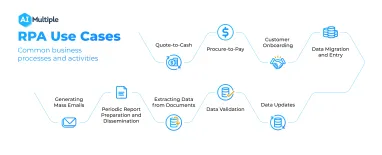
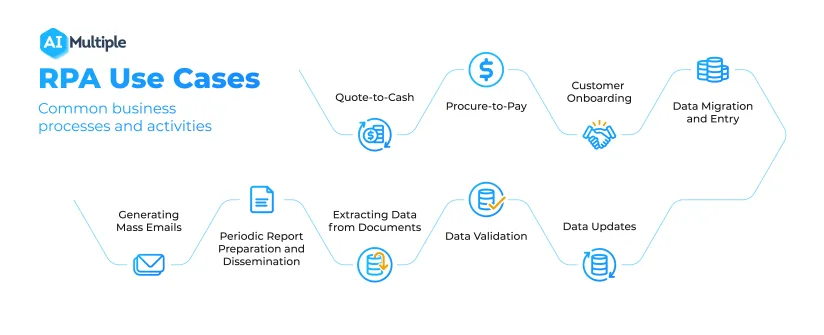
RPA can be used to automate repetitive tasks in the front office and back office.
Some common sectors using RPA include:
In this article, we will explore RPA use cases in 5 buckets:
- Common business processes
- Activities in commercial functions
- Activities in support functions
- Industry-specific processes
- RPA applications for personal use
Disclaimer
Our list of use cases is comprehensive, but not exhaustive.
Since RPA is a horizontal solution, we can’t cover every way that RPA can be used. We recommend businesses use a process mining solution that can identify the most impactful RPA implementation areas for your company based on your company’s as-is processes.
Sponsored:
IBM provides a free-trial of its process mining solution which brings together capabilities including task mining and the digital twin of an organization. IBM process mining can be used to identify the right processes to automate with RPA, saving teams time and effort.
Read about facilitating RPA deployment with process mining for more info.
Common business processes and activities
1. Customer onboarding
The customer onboarding process is critical in reducing customer churn and getting new customers to start using the product.
OCR and RPA can help companies deliver intelligent automation in customer onboarding. Most customer onboarding processes, like contract generation, can even be done in companies relying on legacy systems.
Other activities common to many business functions
2. Data updates
Most departments, including HR, customer service, and marketing, routinely need to update their ever-changing customer/personnel data.
By setting up bots to automatically update relevant data from forms/emails, departments will always have access to the most recent and correct information.
3. Data validation
Most data validation controls can be embedded in databases. But RPA is suitable for other validation tasks, such as cross-checking data against publicly available data. That’s because RPA is easy to program, scalable, and integrable to different systems.
4. Extracting data from PDFs, scanned documents and other formats
Screen scraping, OCR, and basic pattern recognition technologies enable data extraction from almost any format. This reduces the need to extract and input data manually. Explore our data-driven list of the top document-capturing applications. They can be easily integrated into RPA solutions to extract data and process documents.
5. Periodic report preparation and dissemination
Businesses need regular reports to inform managers and teams of their progress. But manual report preparation and sending is time-consuming.
RPA can auto-generate reports, analyze their contents, and based on the contents, email them to relevant stakeholders. This automates periodic reporting.
For example, telecom operators need to send reports on connectivity issues to the correct personnel. For instance, a CTO should be copied in reports with critical issues, and the head of the network with major issues.
RPA bots can analyze reports to modify recipients according to the provided criteria. Learn more about RPA use cases in reporting.
6. Data migration and entry
Legacy systems still perform critical functions at companies. For example, legacy billing systems need to interface with other systems, which may not have the capability to pull relevant data from APIs. In such cases, employees manually migrate data using formats like CSV.
Data migration between new systems can also be complicated when they don’t offer APIs. For example, marketing has ~10,000 applications1 to choose from and some of those solutions do not provide flexible API access.
- Prevent clerical errors
- Automate data migration across different systems
The benefit is improved analytics and decision-making.
7. Generating mass emails
Personalizing emails, newsletters, and other forms of marketing outreach can lead to more successful campaigns. But personalization relies on data inflow from different systems (e.g. CRM or ERP systems), which can be time-consuming if done manually.
RPA can help businesses: :
- Gather customer data from different systems
- Put them onto pre-approved email templates
- Send them to customers/potential leads
8. Quote-to-cash
Businesses need to sell to survive. Quote-to-cash issues can result in late receivables, delayed invoice generation, selling at reduced prices (due to clerical errors), etc.
By streamlined data extraction and transportation from different order forms and systems, quote-to-cash automation enables:
- Manual error reduction
- Faster B2C/B2B services
- Reduction in accountancy costs
9. Procure-to-pay (P2P)/Source-to-pay (S2P)
Procure-to-pay process involves creating a purchase order, and extracting invoice and payment data from multiple systems:
- Supplier emails
- Enterprise resource planning (ERP)
- Customer relationship management (CRM)
- Banks
- Vendors
- Logistics companies.
The data coming in can be in different forms, such as emailed vendor invoices. Invoices need to be captured, validated, and enriched. For example, companies need to assign general ledger (GL) accounts to invoices without purchase orders (POs).
Learn more about RPA use cases in the procurement process.
Activities in commercial functions
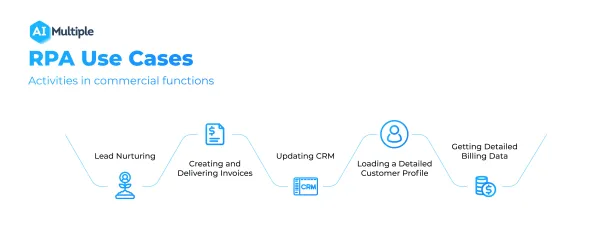
Marketing
10. Lead nurturing
Leads arrive through a myriad of channels such as LinkedIn, lead collection forms and vendors. RPA bots can extract them and put them in a single location.
11. Bid adjustment
Automated bid adjustment tools use RPA-API integration to monitor your ads’ performance, assess it, and automatically adjust the bid.
Although you should keep monitoring the bot’s performance, the need to manually adjust the bid decreases.
Learn more about RPA use cases in marketing.
Competitor monitoring
12. Price monitoring
RPA bots can monitor competitor prices on e-commerce retail websites to track and implement price changes in real-time.
13. Product/service monitoring
The R&D department can use RPA bots to track competitors’ products/services on competitor websites and online retail platforms. The gained insights can shape the company’s offerings.
14. Customer review monitoring
Companies can use RPAs to track, extract, and structure users’ sentiment analysis about their products.
Learn more about competitor monitoring automation
Sales
Though sales personnel should focus on building relations and selling, most of their time is spent on operational activities in most organizations. RPA can automate the interactions between the data systems and the CRM.
15. Creating and delivering invoices
This is a case of data replication. Both the CRM and the accounting systems should have the same sales data. Bots can update accounting records, prepare, and deliver invoices from the right email accounts to ensure data consistency between systems.
16. Updating CRM
Adding interactions with prospects to the CRM is time-consuming but critical.
Modern solutions help companies integrate their email, call, and other communication data into a CRM system. But they require integration into your company’s CRM to work. When such integrations are not available, companies can build bots to update CRM records with customer contact information.
17. Updating scorecards
RPA bots can ensure that CRM changes are uploaded to scorecards. This allows sales reps to see their progress in real-time.
Learn more about sales processes to automate with RPA.
Activities in support functions
Cybersecurity
18. Detecting security breaches
RPA bots can automate security threat detection through:
- Privileged data management
- Detecting malware in emails by specific keywords
- Running cyber threat hunts
L1 (Level 1) Tech support
IT automation use cases include:
19. Regular diagnostics
Regular diagnostic is running preemptive screening of processes. This puts the tech support teams one step ahead and allows them to respond to possible failures before regular users can notice them.
This improves user satisfaction and saves support personnel from wasting time on calls about problems they already know about. There are workload automation (WLA) tools that can be scheduled to run regular diagnostics on the processes to notify users of possible failures.
20. Fault remediation
In fault remediation, conversational AI-enabled RPA bots can leverage responses from command catalogs to troubleshoot users’ problems.
For instance, a user might say the application “keeps crashing.” The chatbot would understand the query, and search the database for the appropriate answer, and give it to the user.
21. Incident management
IT incident management is identifying, solving, and minimizing disruptive incidents in the IT ecosystem.
RPA bots can send a notification to the IT staff automatically when an IT outage is detected. Or they can put all the support tickets in one location, enabling the IT staff to access them easily.
Learn more about data breach incident response.
22. Server monitoring
RPA bots can monitor network and server usage data and send the reports to employees.
Improve tech support by learning other IT automation technologies, such as
- Top 10+ Data Warehouse Automation Software
- Top 12 IT Automation Software in 2023: Vendor Benchmarking
- Top 10 Batch Scheduling Software: Vendor Benchmark
- TOP 5 SAP Job Scheduling Software: Vendor Benchmarking
Customer Relationship Management (CRM)
A customer rep should:
- Understand the customer’s intent
- Perform the necessary actions by switching between different systems
- Inform the customer
A disadvantage is the customer has to wait in line before the rep returns with an answer. The other disadvantage is the reps spend their time answering repetitive queries.
Companies can lower reps’ workload by having RPA bots automate the following:
23. Loading a detailed customer profile
RPA bots can load customers’ profiles (Figure 1) info on demand.
Figure: Example of a customer profile template.
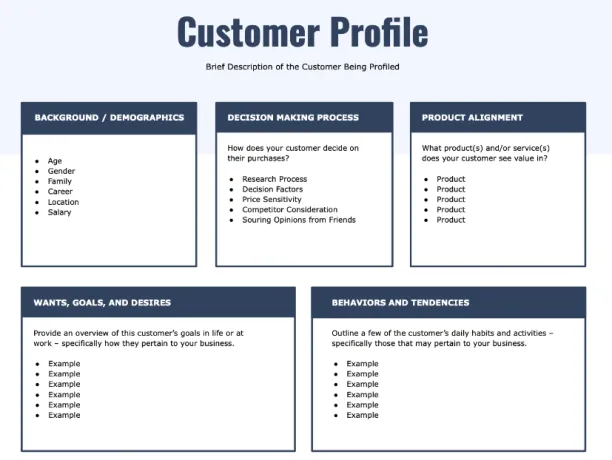
Source: HubSpot
24. Getting detailed billing data
When you call customer service about your most recent payment, you need to stay on the line while the rep pulls your record and reviews it.
With RPA bots, reps can load billing data much quicker.
25. Updating user preferences and other user information
RPA chatbots can update user preferences, addresses, contact/personal information and more. This replaces the need to connect to a live agent.
26. Resolving simple, yet common customer issues
RPA bots can reset a customer’s broadband network, or fix simple connection issues without a rep interacting with multiple windows.
27. Automating multi-step complex tasks that require little decision-making
Some legacy systems require customer service reps to navigate a lot of steps for simple tasks. If these do not require human judgment, they can be automated, saving significant time.
28. Answering FAQs
Companies can build RPA-enabled FAQ chatbots to answer customers’ most frequently asked questions without human intervention.
29. Service Level Agreements (SLAs)
RPA bots can be used to automatically generate SLAs, monitor conformance, give breach notifications, and orchestrate troubleshooting. Learn more about service level agreement automation.
30. Automating multi-step complex tasks that require little decision-making
Some legacy systems force customer service reps to complete numerous steps to complete some common tasks. If these steps do not require human judgment, they can be automated, saving significant time.
31. Spam detection
Approximately:
Companies can use NLP-driven RPA bots to read incoming emails, documents, and online reviews to notice those that are likely to be spam and flag them as such.
32. Automated translation
Especially for international companies, customer complaints, emails, and other forms of correspondence can come in different languages making it harder for customer reps to understand them.
RPA bots can automatically translate the content’s language to allow customer agents to resolve them quickly. Learn more about RPA & NLP integration.
Technology
33. Opening up internal tools to customers or employees
Almost all customer service or tech support departments have internal tools with advanced functionality. Service reps use them for internal and external needs. For example, they may be used to approve payments to vendors even when a 3-way match is not reflected in the systems or enable employees to take additional days off.
If those tools are in legacy systems, it is difficult to expose them directly to customers or employees without training. RPA offers a solution.
The usage frequency of functionalities follows the Pareto principle. A few functionalities (80%) are quite commonly used; the rest (20%) aren’t. After identifying the most popular functionalities of an internal tool, it is possible to write simple web interfaces that leverage bots to complete them.
This saves users time while reducing the burden of support teams. In addition, the functionalities that the internal tools provide would be more targeted enabling more efficient usage.
34. Software installations
RPA can enable single-click installations of complex systems with interdependent components.
35. Automated testing
RPA tools evolved from testing tools that mimic user interactions. The tests can be built into the software, but testing from a user perspective is equally important.
Manual testing is time-consuming; automated RPA testing is fast and can:
- Boost digital transformation of businesses
- Speed-up software development
- Produce more reliable outcomes
- Be run after each deployment to ensure new bugs aren’t introduced
Creative manual tests are required for specific scenarios. But no-code RPA solutions are good for common tests that need to be repeated.
36. Product updates
Companies can automate their product updates to notify their customer base of added capabilities of their product/service line in real time.
The benefit of product update automation is that companies do not have to dedicate manpower to notify customers by emails, messages, or phone calls
Finance
37. Financial planning
Financial planning involves processing and merging financial statements from numerous departments in a Financial Planning & Analysis (FP&A) system. Intelligent RPA bots with OCR features can automate this via data extraction and ETL.
38. Bank statement reconciliation
RPA bots can automate data extraction and reconciliation against ledger entries.
Specifically, RPA can:
- Check for incoming bank statements
- Download and extract file content
- Reconcile them against entries
- Flag exceptions and notify accountants
- Close the books
Learn more about how account reconciliation is automated.
39. Treasury management
RPA in treasury management can automate processes such as:
- Accounts reconciliation
- Forecasting risk factors
- Debt collection
- Investment decisions (for low-risk investments)
- Balance sheet preparation
40. Daily P&L preparation
Large financial institutions, especially those in trading, need to track their profit & loss (P&L) and risk exposures daily.
Companies don’t need to rely on Excel, legacy tools, and manual effort to complete these reports. Some vendors claim2 that they helped a financial services company automate their daily P&L preparation. As a result, reports’ handling time was reduced from an hour to 20 minutes, with higher accuracy.
HR
41. Candidate sourcing
Companies relying on legacy HR systems can use bots to automate aggregating CVs, assessment results, and interview notes.
Businesses can leverage web crawlers which can pull data from platforms such as Glassdoor/LinkedIn to create talent pools, compare candidate data, and understand the job market. Learn more about web scraping use cases in recruiting.
42. Employment history verification
Employment history verification includes numerous, routine steps such as arranging candidate interviews, reaching out to previous employers, and maintaining records. A candidate verification service provider3 implemented an RPA solution in 8 weeks, and used it to reduce 40% of its manual labor.
43. Onboarding
Efficient onboarding and offboarding can reduce the burden on the HR staff and ensure continuity, especially in fast-growing or shrinking firms. In employee onboarding the bot can schedule introductory meetings to speed up orientation.
44. Offboarding
In employee offboarding, the RPA bot can automatically restrict the outgoing employee’s access to confidential company data, calculate compensation packages, and more.
45. Payroll automation
Payroll requires repetitive payroll processing, taking into account myriad regulations and company rules.
While modern payroll software provides a good solution for this process, some companies rely too much on legacy systems to be able to make the switch to modern payroll software.
Figure: Image of a robotic hand signing a pay slip

Source: Inc.
RPA bots can, at least partially, automate the payroll process, such as:
- Automating payroll reports,
- Automating payroll taxes,
- Calculating commissions,
- Collecting timesheets, and more.
46. Absence management
Manual absence management is difficult because:
- Employees might forget to log their off days
- Deductibles for unaccounted vacation days are employee-specific
- The process is time-consuming and prone to human error
Inefficient absence management costs companies ~ $4K/year and $3K/year for each hourly and salaried employee, respectively.
To remedy this, RPA bots can:
- Cross-check employees’ absence reports against their logged-in time in the corporate system
- Alert other team members when an employee adds their info to the vacation calendar.
Figure: Image of a male employee running out of his workplace towards the beach

Source: ARCORO
47. Worker’s compensation claims
An American pharmacy store chain automated its worker’s compensation claims4. By their estimation, on any given day, they have ~2,000 employees nationwide on leave.
RPA allowed them to:
- Automatically load the kind of leave employees were on (i.e., paid/unpaid)
- Exchange the data between the internal database and its claims management service provider
The benefit was that on paydays, employees’ compensations had automatically and accurately reflected their off-days.
48. Expense management
Companies can use RPA tools to automate their expense management. The bot would extract the amount, date, location, and other info from the receipts and log them into the system.
This eliminates the need for employees to hold and submit paper receipts. Moreover, entries will be automated, fast, and accurate..Learn more about expense management automation.
49. HR virtual assistants
An HR virtual assistant can handle most HR processes. For instance, recruiting chatbots can automate parts of the hiring process.
HR virtual assistants can also help employees:
- Register sick leave/vacation time
- Ask about their employee contract stipulations
- Submit expense reports
Learn more about HR technology trends that are shaping the future of HR management.
50. Change management
RPA bots can:
- Gather employees’ change requests’ data
- Screen them
- Evaluate them
- Send them to department heads
- Communicate the results to employees
Learn more about RPA use cases in change management.
Operations
51. Updating inventory records
Inventory management typically involves reconciliation across multiple systems as companies find it challenging to bring all inventory management features under one system.
RPA bots can automate such intersystem reconciliation and communication with ease.
52. Issuing refunds
Unoptimized refund issuance leads to delays and customer dissatisfaction.
This is a concern because customers requesting refunds are already dissatisfied customers. Making them more dissatisfied can lead to severely negative online reviews which hurts companies’ reputations.
53. Compliance
Changing business, regulatory, or tax requirements such as the introduction of VAT5 in the UAE in 2018 requires businesses to validate internal and external records, such as constantly scraping government websites for policy changes.
Learn more about RPA in compliance.
Procurement
54. Updating vendor records
Keeping vendor master files up-to-date to streamline vendor payments.
Updating such files with bots can relieve procurement professionals from simple tasks to focus on managing vendor relationships.
Explore a data-driven list of 23 procurement applications to find the option that best suits your procurement needs.
Industry-specific processes
According to our experience and research, financial services including insurance and BPO (business process outsourcing) seem to be the top users of RPA technologies.
Figure: % of RPA adoption by industry
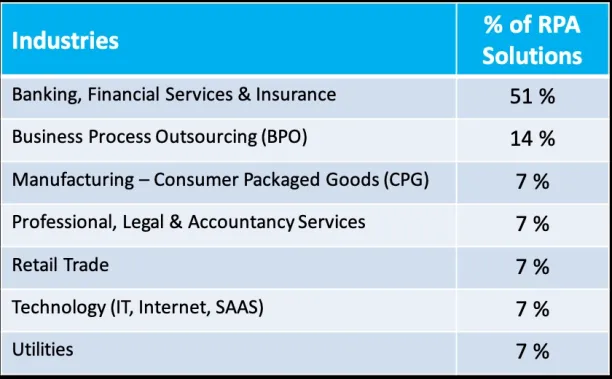
Source: SSON Analytics
Financial Services
55. Know Your Customer (KYC)
Dedicated KYC solutions are emerging. But if your company doesn’t prefer to use one, RPA bots can partially automate the KYC process. And for edge cases that require human intervention, they can be forwarded to an employee.
Figure: Image of a female employee inspecting the information of other employees

Source: Processmaker
56. Loan processing
As with most rules-based, document-processing tasks, loan processing automation is doable with RPA. Business engine rules embedded in bots can:
- Extract applicant info
- Validate it
- Assess the submitted business plan
- Ask users to fix incorrect issues
- Make preliminary evaluation
- Generate confirmation/rejection letters
57. Trade execution
In cases where legacy systems are not capable of storing complex limit orders, RPA bots can automate the processing of complex orders.
58. Same day funds transfers
The co-Operative Bank completes payments using The Clearing House Automated Payment System (CHAPS) which offers same-day funds transfers.
The manual process, which took 10 minutes per request, was automated. The steps included:
- Checking for fund availability
- Making a purchase order
- Performing transfers to where the funds are needed manually
The per-request turnaround time was reduced to a few seconds6. Process steps include checking for fund availability, performing the transfer to the point where manual authorization is required without error, charging the customer, and notifying the account.
59. Account Closure
For The co-Operative Bank, account closure was lengthy and time-consuming. It required the:
- Manual cancellation of direct debits and standing orders,
- Transfer of interest charges,
- And the transfer of funds from one account to another, among other steps.
Now the system is automated with RPA so customer service agents can complete an electronic form over the phone which is sent to a central mailbox where it is processed by the RPA system with no manual intervention7.
60. Validating and processing online loan applications:
RPA can be used to build intermediary bots between the online system and the main frame that use business logic to ask the user to fix incorrect entries, make loan decisions and generate confirmation letters8.
Automating this process frees your employee from manually running preliminary checks on these loan requests.
61. Audits
Banks need to reply to requests by the auditors for company audit reports. Bots can be used to find all the customer’s accounts year-end balances and return the audit to the audit clerk in the form of a Word document.
This can reduce the time it takes to run an average audit from days to minutes.
62. Logistics – Trade Finance
Trade finance involves multiple parties coordinating and ensuring the delivery of goods and payments.
For instance, the banks and the trading company communicate through letters of credit, and other documents, which need to be processed (see diagram below from IBM).
Figure: Automation of trade finance workflow

To learn more about finance automation, read:
Insurance
63. Claims processing
Claims processing is at the heart of every insurance company. Since customers make claims at times of misfortune, a fast and efficient customer experience is crucial.
Some factors that make claims processing biased, delay it, and reduce visibility are:
- Manual/inconsistent processing: Claims processing often involves manual analyses completed by outsourced personnel/claims adjusters.
- Input data of varying formats: Customers send in data in various formats
- Changing regulation: Insurance companies should keep in line with regulation changes through constant staff training and process updates
RPA bots enable claims processing transformation by:
- Taking the unstructured data in forms, structuring, extracting, and assessing them
- Automating claims verification with rules
- Ensuring compliance by changing rules in line with regulatory changes, without the need for re-training staff
- Increasing fraud detection percentage
- Claims Bots can take in unstructured data in forms, structure them, extract them, and finally assess them based on predefined rules.
64. Appeals processing
Some claims might result in appeals because of unmatching dates or other documentation issues. End-to-end appeals processing enables:
- Reading the claims by OCR
- Extracting the complaint and applying the relevant rule with RPA
- Managing the exception with BPM
An RPA vendor automated 89%9 of appeals processing, which involved these tasks, with a 99% accuracy rate.
65. Responding to partner queries
Industries such as telecom or insurance rely on brokers to sell their products and services. It is crucial to serve these partners promptly to maximize their sales.
South African insurance company, Hollard, automated responses to partner queries by building bots that interpreted incoming emails and either resolved them or passed the complex ones to humans.
Learn more about:
Consultants / IT Service Providers / Managed Service Providers / System integrators
66. RPA services
Most companies require support from professional services companies to help
- Identify processes to automate
- Manage the automation project
- Maintain the RPA bots
This is a valuable opportunity for IT service providers to expand into a new domain which can help them reach new customers or grow their relationship with existing customers.
However, choosing an RPA tech partner is not straightforward. RPA service providers or those considering starting to provide RPA services can identify the factors to consider and example vendors in this whitepaper:
Automotive
67. Telematics
Cars leveraging Android Automotive OS are on the rise. RPA can allow automated:
- Over-the-air software updates
- Location data exchange
- Anti-theft protocols updates
- Navigation features updates
Learn more about RPA use cases in the automotive sector.
Aviation
68. Air traffic control
RPA bots can improve air traffic control (ATC) through a constant exchange of data between airplanes’ flight schedules and real-time locations, weather reports, and fueling times.
69. Informing travelers
Airports, airlines, or travel agencies can use RPA to send travelers real-time notifications via apps or emails. Use cases include:
- Informing them of flight schedule changes and gate changes
- Estimated walking time from their specific location to a boarding gate
- Boarding time, etc.
70. Automated check-ins
The check-in kiosks at airports leverage OCR-enabled RPA bots to:
- Scan travelers’ passport barcode
- Cross-match their info with ticket info
- Load up their specific accommodation requests
- Print their luggage and boarding tickets
Agriculture
71. Soil preparation
RPA-IoT integration allows IoT agricultural sensors to extract soil data, such as:
- Soil type
- Nutrient levels
- Moisture levels
RPA bots can structure the data and present the information for data-driven soil preparation.
72. Irrigation
RPA can be one of the technologies to start the smart irrigators whenever IoT sensors indicate a drop in soil moisture level. Moreover, by accessing weather data thanks to agriculture APIs, RPAs can plan the irrigation schedule concerning predicted precipitation levels.
73. Yield prediction
RPA bots can extract soil and crops’ data from the IoT sensors, and the weather report from databases, along with other variables to feed into ML algorithms to predict yield amount.
Note: This is a reductive explanation of how yields can be predicted.
Learn more about RPA use cases in agriculture.
Education
74. Course registration
RPA bots can create personalized, registration semester plans for each student based on their:
- Majors and minors
- Remaining needed credits for graduation
- Available seats in each class
- Expressed interest in elective subjects
75. Exam grading
For multiple choice exams, RPA bots can automatically grade each entry by comparing it against the exam key.
For long answer questions, RPA bots can use NLP and OCR to figure out what the student said and compare it to the possible answers the professor gave.
76. Booking advising sessions
Students need constant advising sessions. These could be meetings with:
- College advisor to see student’s possible college candidates
- Academic advisors in college to see student’s progress
- Immigration advisors in college/high school to ensure international student’s legal status
- Career advisors in college to browse job opportunities after graduation
RPA bots, on school portals, can automatically create meeting time slots between the student and the relevant advisor based on the student’s current status.
77. Shortlisting admission candidates
The top-10 American colleges, in terms of number of applications, received between 65K-109K applications in 2021. Schools and universities can use RPA for the initial screening of applications to eliminate those that do not meet the basic requirement criteria, such as missing documents, spam applications.
The benefit is that the admission personnel can then spend more time on applications that have made it to the next round.
78. Attendance management
RPA bots can be used by teachers to track each student’s attendance. For example, if answering live quiz questions in class is a sign of attendance, RPA bots can match each student’s answer on the day with their name. Or, in virtual classrooms, they can scrape each student’s name and type it into the attendance sheet for that day. Then, they can figure out how many points each student has.
Hospitality
79. Room reservation
RPA bots can reconcile users’ online payments, extract their information from the website’s database, and reserve their rooms automatically.
80. Automated check-ins & check-outs
RPA bots can send periodic notifications or emails to guests to remind them of their check-in and check-out times so misunderstandings about this matter are minimized.
81. Automated room pricing
RPA bots can scrape competitors’ websites for the prices they charge for similar rooms. The data can be put into spreadsheets and sent to the hotel manager for analysis.
The bot can also automatically adjust the hotel’s room prices, based on pre-determined rules, to match the competitors with minimal human intervention.
Learn more about RPA’s use cases in the hospitality industry.
Healthcare
82. Patient Appointment Scheduling
RPA can schedule a patient’s appointments based on diagnosis, doctor availability, location, and other variables including financial statements and insurance information.
83. Enhancing patient care by supporting analytics
RPA bots can collect various medical data. For example, RPA bots can transfer patient data to third-party healthcare analytics services to deliver accurate diagnoses and improved patient care without restricting any confidentiality regulations.
Feel free to check our articles on:
Government
A comprehensive list of RPA use cases in government is listed by Capgemini image shown below:
Figure: RPA use cases in government
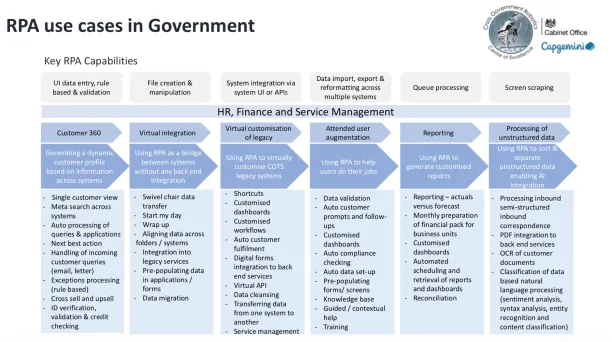
84. Pandemic (e.g.COVID-19) health tracking & alerting automation
RPA bots are claimed to have been used by a health agency to pick up the records of symptomatic people and send alerts to nearest healthcare teams 10. The benefit in reduced manual work in tracking symptomatic people.
Learn more about intelligent automation in government.
Manufacturing
85. Bill of Material (BOM) processing
Bill of material is the document that contains each raw material, component, and the instruction required to manufacture or repair a product. Errors in BOM can affect the production cycle.
RPA can automate Bill of Material processing with OCR, and data extraction technologies based on deep-learning.
86. Inventory control
RPA bots can facilitate inventory controls by alerting you when the stock level is lower than demand.
For instance, an automotive manufacturer[en_note] “Automotive leader implements RPA solution to de-risk its inventory management and reduce stockouts” BirlaSoft. Retrieved on December 21, 2022. [/efn_note] is claimed to have used RPA software to automate inventory control processes.
The bot:
- Reads the emails and notifications received from demand planners. Emails would need to follow certain style guidelines to ensure that the bot picks up data correctly from emails
- Extracts the data from emails and updates the safety stock details in the ERP automatically
- Notifies stakeholders in the process after updating stock levels.
87. Proof of Delivery (POD)
PODs are important for three-way matching and manufacturing planning.
The document is highly labor-intensive and contains a high risk for human errors. RPA bots can track logistics systems and once the delivery occurs, link the shipping data into the warehouse management system.
This frees time from customer service employees along with improving response time.
88. Identifying production malfunction
RPA-IoT integration can notify whether the production equipment is functioning correctly by transferring its real-time status data, such as pistons’ RPM, heat data, vibration level, etc.
Learn more about:
Restaurants
89. Floor management
RPA bots in restaurant POS systems can automatically:
- Split a table’s tab amongst diners
- Allow the simultaneous monitoring of multiple tables’ orders and tabs
- Send waiters notifications whenever a table’s food is ready to serve
- Keep records of the number of diners throughout the day, on each table, the highest/lowest ordered food
90. Meal price updates
RPA bots can be configured to keep track of small changes in the pricing of the ingredients and to automatically increase/decrease the cost of the meal accordingly.
The benefit is that, especially in inflationary times, restaurants can adjust their meal prices for ingredient costs.
Learn more about the use cases of RPA in the food industry.
Retail
Retail includes constant operational and analytics activities, such as launching new products or promotions.
Though RPA companies rely on API connections for such operations, there are still many legacy systems without API interfaces where RPA can be used for integration for completing the following processes:
91. Product categorization
Global retail companies need to harmonize SKU (stock keeping unit) data from multiple markets to be able to look beyond numbers to insights such as, “What is our toothpaste market share in Eastern Europe?”.
Traditionally, these tasks required employees to manually match SKUs to categories in complex spreadsheets. Since this is a task that does not directly impact customers, fault tolerance is not very high and RPA bots can be used to automate the process, saving thousands of hours of work and reducing manual errors.
Everest Group’s report11 provides details on a specific example.
92. Automated returns
Automating returns can improve customer satisfaction and reduce manual labor.
RPA bots can be used to automate the steps of the return process, which include:
- Checking customer purchase records from the system
- Checking the reason for the return
- Asking more questions such as ‘ has the item been worn?’
- Assessing the return’s eligibility
93. Trade promotions
Shop floor trade promotions require back-end admin work. RPA bots can automate relevant tasks such as:
- Creating and allocating funds for promotions
- Generating reports that give visibility of promotion performance
Automation makes it easier and faster for retailers to launch trade promotions.
94. Inventory/supply chain management
Some retailers rely on legacy systems for stockkeeping. RPA bots can perform constant checks on these systems, providing data on key metrics like items with low stock levels or rapidly changing stock levels.
For more, read about intelligent automation in retail and RPA in retail.
Telecom
95. Credit checks
KYC automation can be done for post-paid accounts.
96. SIM swapping
Assigning a new SIM to a user. RPA can help SIM swapping by automating the process of customer authentication, indemnification, and authorization.
97. Customer dispute resolution
Automatically classifying disputes, resolving simple ones,, and assigning the complex ones to related parties is a relatively simple yet effective back-office process to automate through RPA.
98. Porting customer numbers
Utility companies can automate number porting when customers switch operators.
Learn more about RPA use cases on the telecom industry.
Utilities
99. Billing
RPA bots can automatically fill out the billing information on each user’s bill and send it to them.
100. Meter readings
RPA can extract each meter’s usage amount from the meter’s cloud database, put it on the bill, and automatically calculate its cost/watt.
101. Predictive maintenance
Issues in cell towers and cellular wires can cause fires. RPA bots can automatically schedule maintenance by observing each tower’s last maintenance, age, server load, and geographical location.
Learn more about RPA use cases in utilities
RPA applications for personal use
- Hobbyists use free editions of RPA solutions to build bots for personal use for applications like transferring business cards to Salesforce or pulling data from multiple websites to identify the best deals on auction websites
- Another app from a hackathon was built for P&G: An automated receptionist for welcoming visitors to enterprise campuses
For more on RPA
To learn more about RPA, read:
If you believe your business would benefit from adopting an RPA solution, look at our most up-to-date and comprehensive list of RPA products.
Please keep in mind that RPA is not the solution to all business problems. Machine learning expertise may be necessary to automate complex business problems.
Feel free to check our article on intelligent automation use cases for examples of AI/ML-powered RPA. If you need help in identifying solution providers in RPA or another category:
Don’t forget to read our RPA whitepaper:
External Links
Inspired by real-world RPA use cases from reports, 12 vendors’ case studies and our experience.
- 1. “Marketing Technology Landscape 2022.” Chiefmartec. 2022. Retrieved on December 21, 2022.
- 2. Dumitrica, Gratiela (November 23, 2017). “Attended Automation in Action: Three Real World Scenarios.” UiPath. Retrieved on December 21, 2022.
- 3. Dumitrica, Gratiela (November 23, 2017). “Attended Automation in Action: Three Real World Scenarios.” UiPath. Retrieved on December 21, 2022.
- 4. “How Blue Prism’s Digital Workforce is increasing Walgreens’ HR shared service efficiency by 73%.” UiPath. March 2018. Retrieved on December 21, 2022.
- 5. “Value Added Tax (VAT).” U.A.E. Retrieved on December 23, 2022.
- 6. “Blue Prism Drives Efficiencies at The Co-operative Bank.” Blue Prism. Retrieved on December 21, 2022.
- 7. “Blue Prism Drives Efficiencies at The Co-operative Bank.” Blue Prism. Retrieved on December 21, 2022.
- 8. “Blue Prism Drives Efficiencies at The Co-operative Bank.” Blue Prism. Retrieved on December 21, 2022.
- 9. “The Right Way to Combine AI and RPA.” WorkFusion. February 14, 2018. Retrieved on December 21, 2022.
- 10. “COVID-19 health tracking and alerting automation for State Government” UiPath. Retrieved on December 21, 2022.
- 11. “Creating Business Value Through Next-Generation Smart Digital Workforce.” HubSpot. 2017. Retrieved on 23 December, 2022.
- 12. “Thoughtonomy RPA Whitepaper FINAL.” SCRIBD. June, 2016. Retrieved on December 21, 2022.

Cem has been the principal analyst at AIMultiple since 2017. AIMultiple informs hundreds of thousands of businesses (as per similarWeb) including 60% of Fortune 500 every month.
Cem's work has been cited by leading global publications including Business Insider, Forbes, Washington Post, global firms like Deloitte, HPE, NGOs like World Economic Forum and supranational organizations like European Commission. You can see more reputable companies and media that referenced AIMultiple.
Throughout his career, Cem served as a tech consultant, tech buyer and tech entrepreneur. He advised businesses on their enterprise software, automation, cloud, AI / ML and other technology related decisions at McKinsey & Company and Altman Solon for more than a decade. He also published a McKinsey report on digitalization.
He led technology strategy and procurement of a telco while reporting to the CEO. He has also led commercial growth of deep tech company Hypatos that reached a 7 digit annual recurring revenue and a 9 digit valuation from 0 within 2 years. Cem's work in Hypatos was covered by leading technology publications like TechCrunch and Business Insider.
Cem regularly speaks at international technology conferences. He graduated from Bogazici University as a computer engineer and holds an MBA from Columbia Business School.
To stay up-to-date on B2B tech & accelerate your enterprise:
Follow onNext to Read
Top 60+ IT Automation Use Cases in 2024
Top 16 Use Cases of RPA in Education in 2024
Top 12 Hyperautomation Use Cases & Examples in 2024
Great post. Thank you for sharing.
Very useful blog to understand the RPA use cases clearly. Can you please share any use cases in engineering.
Can RPA +AI help in using engineering tools from pdf inputs. like drawing from PDF to Autocad.
Thanks
Hello, Soma. We don’t have an article on RPA-engineering use cases. But we have written on RPA-manufacturing: https://research.aimultiple.com/rpa-manufacturing/. About your specific question: Not that we know of. If this is a common use case, you can contact data extraction vendors for a custom solution.
Incredibly well-written blog! I’ve learned many ideas, many thanks for blogging
Hello, Eshika. We are glad you enjoyed our article!
Please explain on recurring payment automation .
What are the benefits and results.
What are the problem faced before automation to this process
Hello, Chandana! Thank you for your suggestion. We will be writing an article on recurring payments soon.
Great to read about multiple blogs on robotic process automation, we should try to marry AI and ML to create robust robots that would enhance productivity .
This Blog Is Fully Informative. Thank For sharing this Information.
Thank you for sharing about these robotic process automation use cases with us, these will be really helpful to many.. I love reading this blog; it talks so much about planning a great idea about it. Keep sharing such informative articles in future, will be appreciated.
good content to understand
Great read! Automation can find applications in many industries.
Great post. so much information. I tried zetexcel and i found it easy
Thanks!
Thanks for sharing. As in a part of RPA Development services, it gives me more encouragement to work further with more enthusiasm.
Thank you!
Full disclaimer: I work at Nanonets.
Hey,
This is a great blog, thanks for the info! Nanonets OCR is a No Code Data entry automation platform that integrates with leading RPA vendors. You can build a custom deep learning model for any sort of document type with varying diversity in templates. The advantage of a Deep Learning based solution vs a Traditional template based approach is that it’s able to generalize across a variety of formats, image sizes.
Thanks for the heads up!
Valuable information
a clear and depth view what exactly do RPA
Hello AIMultiple,
This list is fantastic. This is probably the 3rd time I am reading it. I feel we can make it a comprehensive list and share to a wider audience across. Each business use case should have a challenge/challenges listed and how RPA can tackle and be a solution to it. I can add some cases as well from Pharma and Finance domain. most recently I am working on Energy sector and could add those as well.
Dear AI Multiple Author, Thank you for providing us readers with an educative article on the uses and application of RPA. Your versatility and subjective command is extraordinary even since your earlier article on Robotic Process Automation. It is a must read for every company looking to convert to RPA as this article provides a complete and elaborate guide on both Industry and Department wise.
Hello, Well written article and elaborately explained. We’d love to share our experiences and case studies to collaborate further.. Would that be possible?
Infrrd AI(https://infrrd.ai/) takes out the pain of capturing data and extracting intelligence from a plethora of documents, delivering you the information you need without having to manually go over documents one by one. The software basically saves you precious time and effort and you never have to worry about accuracy as Infrrd AI uses the latest OCR technologies and their own AI algorithms to ensure the precision of every extracted data.
Infredibly well written blog! I’ve learned many ideas, many thanks for blogging.
Have you got a subscriber list I’m able to register for?
Hello,
We love this piece. My company is wondering if we could connect to share some of our use cases as well.
Thanks so much,
Jessica
Hi Jessica,
Sure, would love to collaborate. Reaching out to you from my aimultiple.com email.
Hi,
Thanks for the valuable information in detailed manner.
Can you please let me know if we would be able to use RPA for SQL server jobs automation process.
We are using SSIS and in order to load the data in daily basis there are few jobs running now as part of another automation tool.
Thanks in advance
Hi Trinath,
Most RPA tools should be able to automate SQL jobs. For example, visualcron provided a short tutorial on this
Your style is really unique compared to other folks I have read stuff from.
Thank you for posting when you have the opportunity, Guess I
will just bookmark this page.
Very well explained but how so some onde do data validation usgin rpa?
While relatively simple checks like data type checks would be automatically performed in databases, more complex validation that includes business rules can be programmed using RPA. For example a customer’s usage may be restricted in complex ways by user’s subscription. This restriction can be programmed in a simple RPA bot that regularly validates data and highlights anomalies

![Top RPA Training Courses to Become an RPA Developer [2024]](https://research.aimultiple.com/wp-content/uploads/2018/04/rpa-training-190x107.png.webp)
Comments
Your email address will not be published. All fields are required.